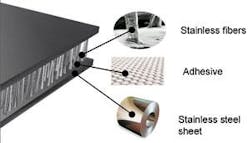Lightweight stainless steel sandwich material could transform structural engineering
Steel fiber flocking gives lattice construction
Weight and strength of materials are major concerns for designers of offshore installations. Engineering would be more straightforward if steel had the weight of aluminum and aluminum the strength of steel.
A new stainless steel sandwich material, developed by Volvo, could provide a solution. The material, named Hybrix, consists of two sheets of stainless steel joined by microscopic stainless steel fibers, each 1-2 mm long and 20-40 microns in diameter. Using static electricity in a technique known as flocking, the fibers are installed as lattice beams between the two sheets and fixed in place with adhesive. Each fiber can work independently, as the core consists 90-95% of air.
The resulting construction is a material that has almost the same structural strength as a sheet of stainless steel of the same thickness, but only around one third the weight - and roughly the same weight as an equivalent sheet of aluminum. A further advantage is that, as a stainless steel, Hybrix has strong corrosion-resistant qualities.
Volvo developed Hybrix in its search for a strong, lightweight material for use in cars. Volvo Technology Transfer appointed the business development department at Chalmers University of Technology in Gothenburg to develop applications and markets. For this purpose, the university created a new company, called Lamera.
Lamera’s efforts are currently concentrated mainly on the aircraft, defense, and consumer goods industries. In an aircraft context, the material is of interest for secondary structures such as galley and toilet walls and structures, and for defense purposes as part of an explosion protection system. However, according to marketing head Mattias Grufberg, it should also have a role to play in the offshore sector.
Hybrix’s sandwich construction makes it particularly suitable for absorbing kinetic energy. Tests at the Massachusetts Institute of Technology showed that it has a short folding wavelength. When subjected to pressure from above, it collapses in small folds, absorbing more kinetic energy than an equivalent steel sheet, which collapses in large folds.
This property suggests the material has possibilities as a lightweight safety barrier, for example, providing protection against blasts in hazardous production areas on an offshore installation.
Hybrix also offers interesting properties as a fire barrier, Grufberg says. As the temperature rises, the adhesive binding the fibers to the sheets melts and the core widens. Although this leads to a loss of strength, it retards significantly the melting or collapse of the material by providing more effective insulation than a single steel sheet.
A wide variety of dimensions can be specified for the laminates and the core. Lamera has mainly worked with sheets of 0.2 mm and a 1 mm core, giving a total width of 1.4 mm. Among stainless steel grades, it has mostly used 316L and 304.
Hybrix appears to have less impact on the environment than alternative materials. Its high load-bearing capacity means that less material is consumed during manufacture than is the case for lower-capacity steels. It also requires less energy during use and in transportation. And it can be recycled easily, since both sheets and fibers, being made of the same metal, can be melted down to raw material together with the adhesive burning off.
Being no thicker than a single steel sheet - and since each fiber works independently - Hybrix has much greater formability than conventional sandwich structures. It can be shaped into double-curved forms.
The properties can be varied by altering the specifications. A 1 mm fiber provides the optimal length for achieving structural strength. The strength falls away as the fiber is lengthened beyond 1 mm. On the other hand, the energy absorption capacity is increased by using longer fibers. Hybrix sections could therefore be constructed with different energy absorption capacities at different locations.
Having a sandwich construction, other components can be built into it, such as pressure sensors, or heating cables, or sensitive cables requiring protection. Areas subject to high stress could have their strength boosted by inserting solid material between the sheets.
Hybrix is not ideal for welding as it is so thin, although it has been welded successfully by means of resistance welding. But weldability can be substantially increased in local prefabricated areas by inserting pieces of solid steel sheet to fill up the gap.•
For more information, contact Mattias Grufberg, Lamera. Tel +46 31 772 6095, fax +46 31 772 8091, [email protected], www.lamera.se.

